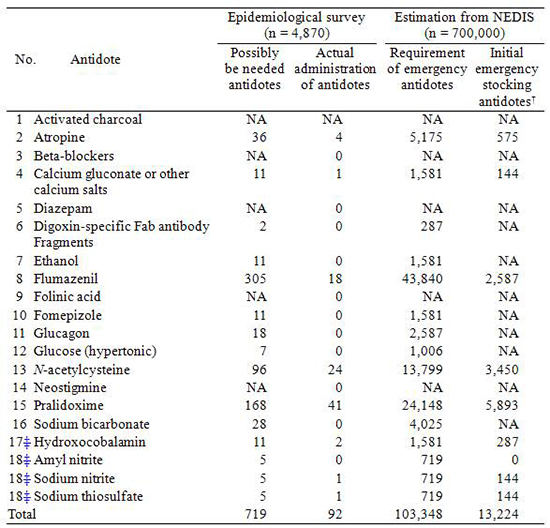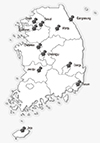1. Korea National Statistical Office. Annual report on the cause of death statistics: based on vital registration in year 2011. Daejeon: Statistics Korea;2010.
2. Centers for Disease Control and Prevention (CDC). Unintentional poisoning deaths: United States, 1999-2004. MMWR Morb Mortal Wkly Rep. 2007; 56:93–96.
3. Bronstein AC, Spyker DA, Cantilena LR Jr, Green JL, Rumack BH, Giffin SL. 2009 Annual Report of the American Association of Poison Control Centers' National Poison Data System (NPDS): 27th Annual Report. Clin Toxicol (Phila). 2010; 48:979–1178.
4. Dart RC, Stark Y, Fulton B, Koziol-McLain J, Lowenstein SR. Insufficient stocking of poisoning antidotes in hospital pharmacies. JAMA. 1996; 276:1508–1510.
5. Dart RC, Borron SW, Caravati EM, Cobaugh DJ, Curry SC, Falk JL, Goldfrank L, Gorman SE, Groft S, Heard K, et al. Expert consensus guidelines for stocking of antidotes in hospitals that provide emergency care. Ann Emerg Med. 2009; 54:386–394.
6. Ong HC, Yang CC, Deng JF. Inadequate stocking of antidotes in Taiwan: is it a serious problem? J Toxicol Clin Toxicol. 2000; 38:21–28.
7. Gorman SK, Zed PJ, Purssell RA, Brubacher J, Willis GA. Antidote stocking in British Columbia hospitals. CJEM. 2003; 5:12–17.
8. Hrubý K. Availability of antidotes in hospital pharmacies in the Czech Republic. Ceska Slov Farm. 2003; 52:231–240.
9. Jacobsen P, Kristensen TR, Jensen K. Availability of antidotes in Denmark. Ugeskr Laeger. 2004; 166:4257–4260.
11. Persson HE, Sjöberg GK, Haines JA, Pronczuk de Garbino J. Poisoning severity score. Grading of acute poisoning. J Toxicol Clin Toxicol. 1998; 36:205–213.
12. Pronczuk de Garbino J, Haines JA, Jacobsen D, Meredith T. Evaluation of antidotes: activities of the International Programme on Chemical Safety. J Toxicol Clin Toxicol. 1997; 35:333–343.
13. Dart RC, Goldfrank LR, Chyka PA, Lotzer D, Woolf AD, McNally J, Snodgrass WR, Olson KR, Scharman E, Geller RJ, et al. Combined evidence-based literature analysis and consensus guidelines for stocking of emergency antidotes in the United States. Ann Emerg Med. 2000; 36:126–132.
14. Wolf SJ, Heard K, Sloan EP, Jagoda AS. American College of Emergency Physicians. Clinical policy: critical issues in the management of patients presenting to the emergency department with acetaminophen overdose. Ann Emerg Med. 2007; 50:292–313.
15. Wiens MO, Zed PJ, Lepik KJ, Abu-Laban RB, Brubacher JR, Gorman SK, Kent DA, Purssell RA. Adequacy of antidote stocking in British Columbia hospitals: the 2005 Antidote Stocking Study. CJEM. 2006; 8:409–416.
16. Burillo-Putze G, Munne P, Duenas A, Pinillos MA, Naveiro JM, Cobo J, Alonso J. Clinical Toxicology Working Group. Spanish Society of Emergency Medicine (SEMESTOX). National multicentre study of acute intoxication in emergency departments of Spain. Eur J Emerg Med. 2003; 10:101–104.
17. Solheim L, Andrew E, Jacobsen D. Antidote availability in Norway. Tidsskr Nor Laegeforen. 2002; 122:1111–1113.
18. Plataki M, Anatoliotakis N, Tzanakis N, Assithianakis P, Tsatsakis AM, Bouros D. Availability of antidotes in hospital pharmacies in Greece. Vet Hum Toxicol. 2001; 43:103–105.
19. Marraffa JM, Cohen V, Howland MA. Antidotes for toxicological emergencies: a practical review. Am J Health Syst Pharm. 2012; 69:199–212.
20. Blizzard JC, Michels JE, Richardson WH, Reeder CE, Schulz RM, Holstege CP. Cost-benefit analysis of a regional poison center. Clin Toxicol (Phila). 2008; 46:450–456.
21. Bronstein AC, Spyker DA, Cantilena LR Jr, Rumack BH, Dart RC. 2011 Annual report of the American Association of Poison Control Centers' National Poison Data System (NPDS): 29th Annual Report. Clin Toxicol (Phila). 2012; 50:911–1164.
22. Sivilotti ML, Eisen JS, Lee JS, Peterson RG. Can emergency departments not afford to carry essential antidotes. CJEM. 2002; 4:23–33.
23. Paulozzi LJ, Xi Y. Recent changes in drug poisoning mortality in the United States by urban-rural status and by drug type. Pharmacoepidemiol Drug Saf. 2008; 17:997–1005.
24. Simonsen KW, Normann PT, Ceder G, Vuori E, Thordardottir S, Thelander G, Hansen AC, Teige B, Rollmann D. Fatal poisoning in drug addicts in the Nordic countries in 2007. Forensic Sci Int. 2011; 207:170–176.
25. World Health Organization, the United Nations Environment Programme, the International Labour Organisation. Guidelines for poison control. Geneva, Switzerland: World Health Organization;1997. p. 59.







 PDF
PDF ePub
ePub Citation
Citation Print
Print








 XML Download
XML Download